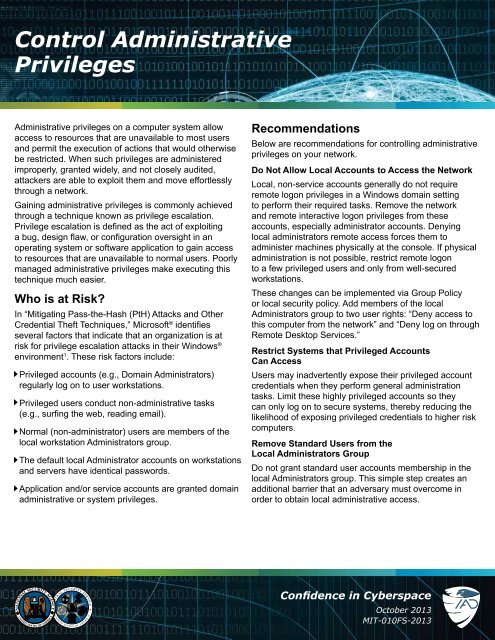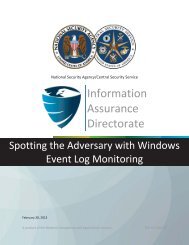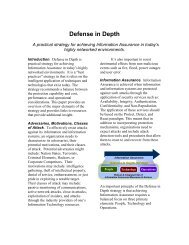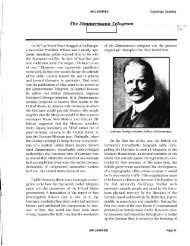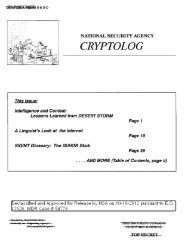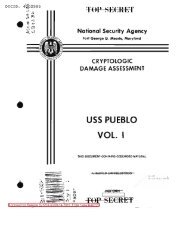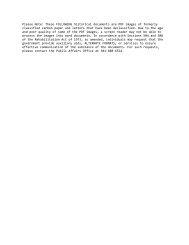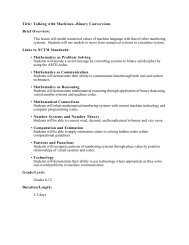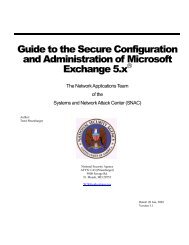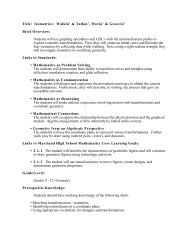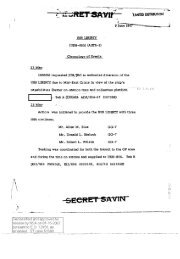Control Administrative Privileges
Control Administrative Privileges
Control Administrative Privileges
You also want an ePaper? Increase the reach of your titles
YUMPU automatically turns print PDFs into web optimized ePapers that Google loves.
<strong>Control</strong> <strong>Administrative</strong><br />
<strong>Privileges</strong><br />
<strong>Administrative</strong> privileges on a computer system allow<br />
access to resources that are unavailable to most users<br />
and permit the execution of actions that would otherwise<br />
be restricted. When such privileges are administered<br />
improperly, granted widely, and not closely audited,<br />
attackers are able to exploit them and move effortlessly<br />
through a network.<br />
Gaining administrative privileges is commonly achieved<br />
through a technique known as privilege escalation.<br />
<br />
<br />
operating system or software application to gain access<br />
to resources that are unavailable to normal users. Poorly<br />
managed administrative privileges make executing this<br />
technique much easier.<br />
Who is at Risk?<br />
In “Mitigating Pass-the-Hash (PtH) Attacks and Other<br />
Credential Theft Techniques,” Microsoft ® <br />
several factors that indicate that an organization is at<br />
risk for privilege escalation attacks in their Windows ®<br />
environment 1 . These risk factors include:<br />
Privileged accounts (e.g., Domain Administrators)<br />
regularly log on to user workstations.<br />
Privileged users conduct non-administrative tasks<br />
<br />
Normal (non-administrator) users are members of the<br />
local workstation Administrators group.<br />
The default local Administrator accounts on workstations<br />
and servers have identical passwords.<br />
Application and/or service accounts are granted domain<br />
administrative or system privileges.<br />
Recommendations<br />
Below are recommendations for controlling administrative<br />
privileges on your network.<br />
Do Not Allow Local Accounts to Access the Network<br />
Local, non-service accounts generally do not require<br />
remote logon privileges in a Windows domain setting<br />
to perform their required tasks. Remove the network<br />
and remote interactive logon privileges from these<br />
accounts, especially administrator accounts. Denying<br />
local administrators remote access forces them to<br />
administer machines physically at the console. If physical<br />
administration is not possible, restrict remote logon<br />
to a few privileged users and only from well-secured<br />
workstations.<br />
These changes can be implemented via Group Policy<br />
or local security policy. Add members of the local<br />
Administrators group to two user rights: “Deny access to<br />
this computer from the network” and “Deny log on through<br />
Remote Desktop Services.”<br />
Restrict Systems that Privileged Accounts<br />
Can Access<br />
Users may inadvertently expose their privileged account<br />
credentials when they perform general administration<br />
tasks. Limit these highly privileged accounts so they<br />
can only log on to secure systems, thereby reducing the<br />
likelihood of exposing privileged credentials to higher risk<br />
computers.<br />
Remove Standard Users from the<br />
Local Administrators Group<br />
Do not grant standard user accounts membership in the<br />
local Administrators group. This simple step creates an<br />
additional barrier that an adversary must overcome in<br />
order to obtain local administrative access.<br />
<br />
October 2013<br />
MIT-010FS-2013
Ensure <strong>Administrative</strong> Accounts Do Not Have<br />
Email Accounts or Internet Access<br />
Privileged accounts should not be used to perform<br />
general tasks such as accessing emails and browsing<br />
the Internet. Additionally, on servers, disable/remove<br />
browsing and e-mail capability altogether if not necessary<br />
for the server applications to function. Email and Internet<br />
browsing activities are inherently dangerous because<br />
they may involve processing information that is potentially<br />
malicious. If accounts with administrative privileges are<br />
used to perform these activities, a potential compromise<br />
can lead to immediate attacker control of those rights.<br />
Follow the Principle of Least Privilege<br />
Members in privileged groups are high value targets<br />
for attackers. Reduce the number of members in these<br />
groups and only give users the permissions they need to<br />
do their jobs. Very few users should have domain admin<br />
credentials, and domain admin logons should be used<br />
only for activities that require that privilege level.<br />
Use Multi-Factor Authentication<br />
In order for users to be granted access to network<br />
resources, make them prove that they are who they<br />
say they are. The user can be authenticated by what<br />
he has (e.g. an ID card or token), what he knows (e.g.<br />
a password or PIN), or what he is (e.g. biometric data).<br />
For all privileged accounts, use a robust authentication<br />
process that requires at least two of these factors.<br />
Manage Passwords Effectively<br />
Text passwords are inherently weak and can be<br />
cracked or compromised given enough time and effort.<br />
If multi-factor authentication is not possible, passwords<br />
for administrative accounts should be complex and<br />
contain a combination of letters, numbers, and special<br />
<br />
length (generally for Windows systems, greater than 14<br />
characters). Consider using longer passphrases instead<br />
of typical passwords. Require regular password changes<br />
for all administrative and other privileged accounts, and<br />
ensure the passwords are different from other accounts.<br />
Finally, if passwords are stored for emergency access,<br />
keep these in a protected off-network location, preferably<br />
in a safe.<br />
Additional Information<br />
Best Practices for Securing Active Directory<br />
http://www.microsoft.com/en-us/download/details.<br />
aspx?id=38785<br />
Enforcing No Internet or Email from Privileged Accounts<br />
<br />
Final_49635NonInternetsheet91.pdf<br />
Mitigating Pass-the-Hash (PtH) Attacks<br />
and Other Credential Theft Techniques<br />
http://www.microsoft.com/en-us/download/details.<br />
aspx?id=36036<br />
Reducing the Effectiveness of Pass-the-Hash<br />
<br />
Effectiveness_of_Pass-the-Hash.pdf<br />
Twenty Critical Security <strong>Control</strong>s for Effective<br />
Cyber Defense: Consensus Audit Guidelines<br />
http://www.sans.org/critical-security-controls/<br />
Contact Information<br />
Industry Inquiries: 410-854-6091<br />
USG/IC Client Advocates: 410-854-4790<br />
DoD/Military/COCOM Client Advocates: 410-854-4200<br />
General Inquiries: niasc@nsa.gov<br />
Disclaimer of Endorsement:<br />
products, process, or service by trade name, trademark, manufacturer,<br />
or otherwise, does not necessarily constitute or imply its endorsement,<br />
recommendation, or favoring by the United States Government. The views<br />
<br />
those of the United States Government, and shall not be used for advertising<br />
or product endorsement purposes.<br />
1<br />
Microsoft ® and Windows ® are registered trademarks of Microsoft Corp.<br />
<br />
October 2013<br />
MIT-010FS-2013


